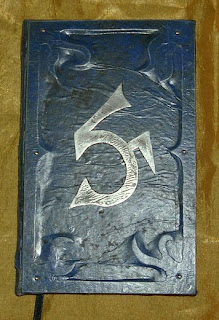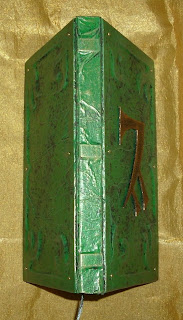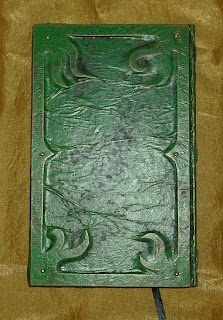
I set aside the cement that came in the kit and decided to test the mold with plaster instead. I mixed Plaster of Paris (hereafter referred to as PoP) with dental plaster, which is much more expensive but about 20 times stronger. The first casting I made came out very badly, as the plaster started to set up before I got it all into the mold. I decided to let it cure anyway and use it as a test piece. After I finished painting it, I actually like it better than the one that came out "good". It looks like an ancient piece of stonework, ravaged by time and the elements.

This kind of got me into a plaster casting mode. I started looking around the shop for other things I could make plaster castings of. I selected two "sun" plaques and started making latex rubber molds of them, but that effort was stalled when I ran out of rubber. The local craft store usually caries it, but they have been out of stock for a month or more. Then my sales clerk brought in a collection of candle molds for me to try out. She has about a dozen different molds, some rubber some plastic. I tried out five of them so far. Here are some of the results.

I again used a combination of PoP and dental plaster (Excalibur brand). I had to touch up some surface air holes and the Bast and Goddess molds left a lot of flash that needed to be cleaned up and smoothed out. Then I used a clear sealer on them before painting. I gave each a base coat of black acrylic paint, followed by a rough coat of blackened bronze metallic paint (intentionally missing some spots). Then I used a spray on matte sealer followed by highlights dry brushed with blond bronze metallic paint. I used the sealer before the highlight coat because my first attempt started to pull the bronze and base coats off when I dry brushed. I think the finish looks even more realistic than my usual "antique bronze" finish that I use. The main difference being that I normally mix the blackened and the blond bronze for my mid coat and use gold acrylic and rub-n-buff for the highlights. This method, of using the blond bronze for the highlights, seems to give a more muted finish that seems more realistic to me.

I liked the way these came out so well that I decided to sell them for $25 each in my shop. I think that is still a pretty good price as statuary seems to be pretty expensive. This past summer we had ceramic god and goddess statues that were consignment pieces. They were very plain and wobbled on their bases something terrible. I didn't think much of them at all. Our consignors wanted $45 each for them and they both sold. If these sell well, I will definitely be making more of them.










































